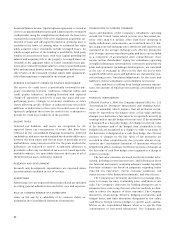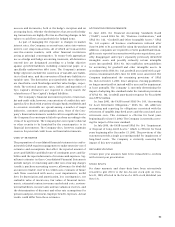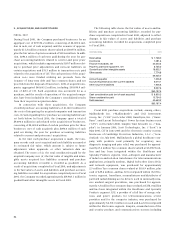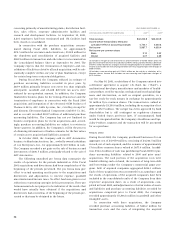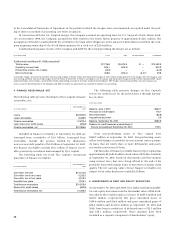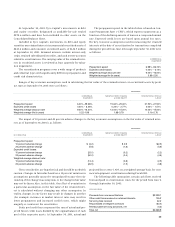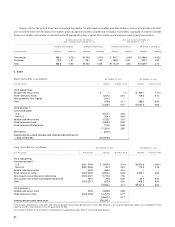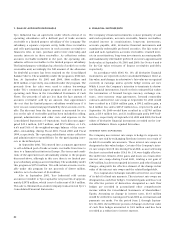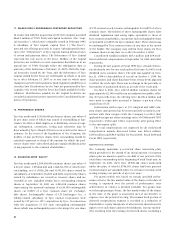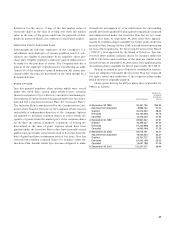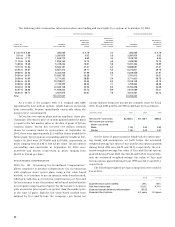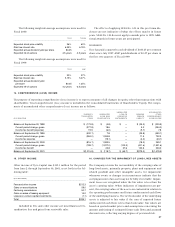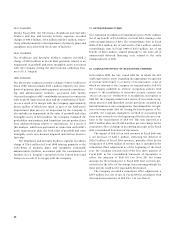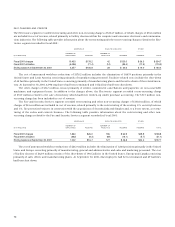ADT 2001 Annual Report Download - page 64
Download and view the complete annual report
Please find page 64 of the 2001 ADT annual report below. You can navigate through the pages in the report by either clicking on the pages listed below, or by using the keyword search tool below to find specific information within the annual report.
62
7. SALE OF ACCOUNTS RECEIVABLE
Tyco Industrial has an agreement under which several of its
operating subsidiaries sell a defined pool of trade accounts
receivable to a limited purpose subsidiary of the Company. The
subsidiary, a separate corporate entity, holds these receivables
and sells participating interests in such accounts receivable to
financiers who, in turn, purchase and receive ownership and
security interests in those receivables. As collections reduce
accounts receivable included in the pool, the operating sub-
sidiaries sell new receivables to the limited purpose subsidiary.
The limited purpose subsidiary has the risk of credit loss on the
receivables and, accordingly, the full amount of the allowance
for doubtful accounts has been retained on the Consolidated
Balance Sheets. The availability under the program is $500 mil-
lion. At September 30, 2001 and 2000, $466 million and
$450 million, respectively, was utilized under the program. The
proceeds from the sales were used to reduce borrowings
under TIG’s commercial paper program and are reported as
operating cash flows in the Consolidated Statements of Cash
Flows. The proceeds of sale are less than the face amount of
accounts receivable sold by an amount that approximates
the cost that the limited purpose subsidiary would incur if it
were to issue commercial paper backed by these accounts receiv-
able. The discount from the face amount is accounted for as a
loss on the sale of receivables and has been included in selling,
general, administrative and other costs and expenses in the
Consolidated Statements of Operations. Such discount aggre-
gated $25.3 million, $25.7 million, and $15.7 million, or 5.3%,
6.6% and 5.6% of the weighted-average balance of the receiv-
ables outstanding, during Fiscal 2001, Fiscal 2000 and Fiscal
1999, respectively. The operating subsidiaries retain collection
and administrative responsibilities for the participating inter-
ests in the defined pool.
In September 2001, TIG entered into a separate agreement
to sell a defined pool of trade accounts receivable from time to
time to a financial institution in Europe. The terms and condi-
tions of the agreement are substantially similar to the program
discussed above, although in this case there is no limited pur-
pose subsidiary acting as an intermediary. The availability under
this program is $175.0 million. TIG sold certain accounts receiv-
able under this program for net proceeds of $160.0 million,
which is net of a discount of $1.4 million.
Also in September 2001, Tyco Industrial sold certain
accounts receivable to Tyco Capital for net proceeds of approxi-
mately $297.8 million, which is net of a discount of $4.3 million.
This sale is eliminated as an intercompany transaction in Tyco’s
Consolidated Financial Statements.
8. FINANCIAL INSTRUMENTS
The Company’s financial instruments consist primarily of cash
and cash equivalents, accounts receivable, finance receivables,
retained interest in securitizations, long-term investments,
accounts payable, debt, derivative financial instruments and
mandatorily redeemable preferred securities. The fair value of
cash and cash equivalents, accounts receivables, retained inter-
ests in securitizations, long-term investments, accounts payable
and mandatorily redeemable preferred securities approximated
book value at September 30, 2001 and 2000. See Notes 4 and 6
for the fair value estimates of finance receivables and debt,
respectively.
In accordance with SFAS No. 133, all derivative financial
instruments are reported on the Consolidated Balance Sheet at
fair value, and changes in a derivative’s fair value are recognized
currently in earnings unless specific hedge criteria are met.
While it is not the Company’s intention to terminate its deriva-
tive financial instruments, based on their estimated fair values
the termination of forward foreign currency exchange con-
tracts, cross-currency swap agreements, forward commodity
contracts and interest rate swaps at September 30, 2001 would
have resulted in a $120.4 million gain, a $93.2 million gain, a
$6.8 million loss and a $103.9 million loss, respectively, and at
September 30, 2000 would have resulted in a $279.0 million
gain, a $15.3 million loss, an $11.1 million gain and a $95.7 mil-
lion loss, respectively. At September 30, 2001 and 2000, the book
values of derivative financial instruments recorded on the Con-
solidated Balance Sheets equaled fair values.
INTEREST RATE EXPOSURES
The Company uses interest rate swaps to hedge its exposure to
interest rate risk by exchanging fixed rate interest on certain of
its debt for variable rate amounts. These interest rate swaps are
designated as fair value hedges. Certain of the Company’s inter-
est rate swaps entered into during Fiscal 2001, as assessed using
the short-cut method under SFAS No. 133, were highly effective.
The ineffective element of the gains and losses on certain other
interest rate swaps during Fiscal 2001, totaling a net gain of
$19.7 million, has been recognized in interest and other financial
charges, along with the effective element of the change in fair
value of the interest rate swaps and the related hedged debt.
Tyco Capital also exchanges variable rate interest on certain
of its debt for fixed rate amounts. These interest rate swaps are
designated as cash flow hedges. Unrealized gains and losses on
the effective portion of derivatives designated as cash flow
hedges are recorded in accumulated other comprehensive
income within the Consolidated Statements of Shareholders’
Equity. Assuming no change in interest rates, $13.5 million
would be credited to earnings in Fiscal 2002 as contractual cash
payments are made. For the period June 2 through Septem-
ber 30, 2001, the ineffective portion of changes in the fair value
of cash flow hedges amounted to $3.9 million and has been
recorded as a reduction to interest expense.


